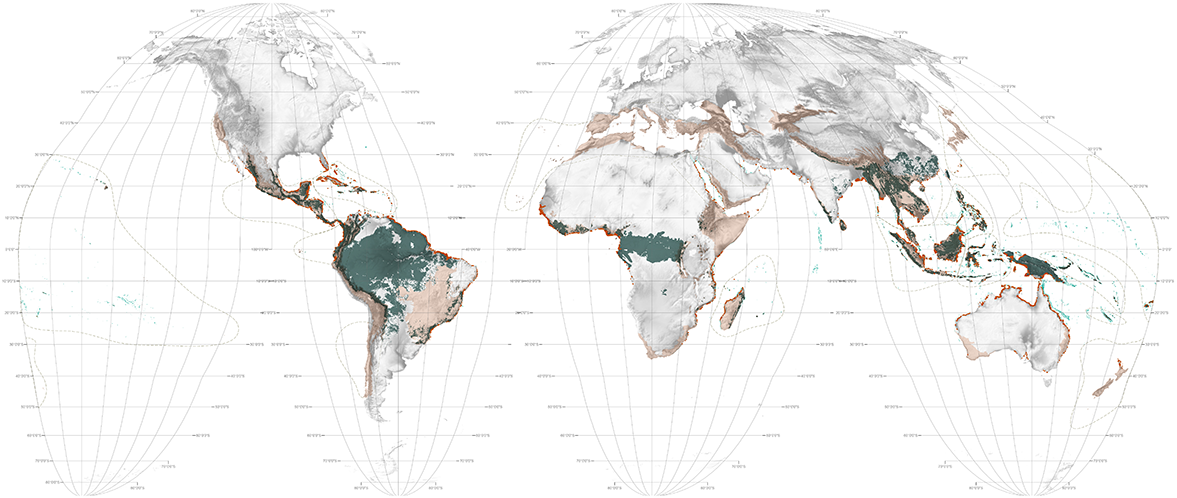Tropical and sub-tropical rainforests contain over half of the world's biodiversity and considerable cultural diversity amongst the peoples whose spiritual and material livelihoods are forest dependent. Rainforests also play a major role in regulating the global atmospheric and hydrological cycles, providing the world with one fifth of its oxygen and absorbing one third of its carbon emissions. 1
Before modern agriculture, tropical rainforests covered about 1.6 billion hectares of the earth's surface. In his 2015 report to the Club of Rome on the state of the world's rainforests, Claude Martin estimates that half have been eradicated due to agriculture, logging and mining, much of this occurring in the last few decades. 2 A further one quarter of the world's rainforests is, according to Martin, degraded. It is currently estimated that 4.9 million hectares of rainforest are lost each year. At this rate the earth's entire rainforest biome — exempting the 9.8% (2008) under protection — will be eradicated in a little over 100 years from now. 3 To do this would be to radically destabilize an already unbalanced earth system and sacrifice life's most prodigious biodiversity before it is barely documented. In return we will get relatively small quantities of palm oil, soy beans, cocoa and beef. 4
Mangroves
Once associated with filth and disease, Mangrove 'swamps' are now appreciated as the rainforests of the inter-tidal zone. Mangroves incubate and harbor marine biodiversity and, by filtering silt and run-off, they protect offshore coral reefs. Additionally, mangroves function as flood control and storm surge barriers enhancing the resilience of coastal cities now threatened by sea-level rise.
According to the 2010 World Atlas of Mangroves the global area of mangroves was 15,000,000 hectares. 5 The United Nation's Food and Agriculture Organization (FAO) estimates that 35,600 km2 of mangroves were eradicated between 1980 and 2005. 6 Between 2001 through to 2012, 9,000 and 25,0000 hectares have been lost annually. 7 Mangrove clearance is primarily due to coastal development and the expansion of aquaculture. Mangroves are also killed by eutrophication, oil spills, changes to tidal conditions and the harvesting of mangrove wood for the production of high quality charcoal.
Coral Reefs
Arguably the most beautiful and certainly the most colorful of life's creations, coral reefs are to the marine ecosystem what rainforests are to the terrestrial. They are also premier tourist attractions and major fisheries. Occupying less than 0.25% of marine environments, "coral reefs are home to more than 25% of all known marine fish species." 8 The world's reefs are primarily threatened by the run off of fertilizers, pesticides and silt as well as the increasing acidification of the oceans and increasing water temperatures in connection with global climate change. The result of such changes is referred to as coral bleaching, which usually leads to the death of the coral, unless water temperatures return to their mean.
From 1876-1979 only three major bleaching events were recorded, whereas in 2002 more than 400 such events were recorded. 9 From Southeast Asia down to the north eastern coast of Australia there are 10,000,000 hectares of coral reefs (34% of the world's total) which are home to over 600 of the 800 reef-building coral species in the world. Scientists have reported that over 500 reefs from Cairns to Papua New Guinea are currently bleaching. 10 In a June 2016 press release, the US National Oceanic and Atmospheric Administration (NOAA) said that this bleaching event, which began in 2014, will continue, thus becoming the longest in recorded history. 11 The world heritage status of the Great Barrier Reef in Australia is now in question.
1 Claude Martin, On the Edge: The State and Fate of the World's Tropical Rainforests, Report to the Club of Rome (Vancouver and Berkeley: Greystone Books, 2015).
2 ibid.
3 Toby A. Gardner, et al., "Prospects for tropical forest biodiversity in a human-modified world," Ecology Letters 12, no. 6 (2009): 561-582.
4 Vaughan, S. The State and Fate of Tropical Forests. International Institute for Sustainable Development. 2015. Available at http://www.iisd.org/sites/default/files/publications/state-fate-tropical-rainforests-commentary.pdf.
5 Mark Spalding, Mami Kainuma, & Lorna Collins, World Atlas of Mangroves (London and Washington, DC: Earthscan, 2010).
6 Ramsar, "World Atlas of Mangroves: a global assessment of the state of the world's mangroves recently published," http://www.ramsar.org/news/world-atlas-of-mangroves-a-global-assessment-of-the-state-of-the-worlds-mangroves-recently (accessed September 9, 2016).
7 Asa Strong & Susan Minnemeyer, "Satellite Data Reveals State of the World's Mangrove Forests," World Resources Institute (February 20, 2015), http://www.wri.org/blog/2015/02/satellite-data-reveals-state-world%E2%80%99s-mangrove-forests.
8 World Wildlife Fund, "Fast facts: why coral reefs are important to people," http://wwf.panda.org/about_our_earth/blue_planet/coasts/coral_reefs/coral_facts/ (accessed June 1, 2016).
9 Ibid.
10 James Cook University, "Coral Bleaching Taskforce documents most severe bleaching on record" (March 29, 2016), https://www.jcu.edu.au/news/releases/2016/march/coral-bleaching-taskforce-documents-most-severe-bleaching-on-record (accessed June1, 2016).
11 National Oceanic and Atmospheric Administration (NOAA), "U.S. coral reefs facing warming waters, increased bleaching" (June 20, 2016), http://www.noaa.gov/us-coral-reefs-facing-warming-waters-increased-bleaching (accessed June 1, 2016).
1. Forests
Source: Hansen/UMD/Google/USGS/NASA
M. C. Hansen, et al., "High-Resolution Global Maps of 21st-Century Forest Cover Change," Science 342, no. 6160 (2013): 850-853. Data available at http://earthenginepartners.appspot.com/science-2013-global-forest (accessed August 2, 2015). Data made available under the Creative Commons Attribution 4.0 International License: https://creativecommons.org/licenses/by/4.0/legalcode.
2. Mangroves
M. D. Spalding, F. Blasco, & C. Field (eds.), World Mangrove Atlas (Okinawa,Japan: International Society for Mangrove Ecosystems, 1997), 178. Compiled by UNEP-WCMC, in collaboration with the International Society for Mangrove Ecosystems (ISME). (version 3). Available at https://archive.org/details/worldmangroveatl97spal (accessed October 13, 2014).
3. Coral Reefs
UNEP-WCMC, WorldFish Centre, WRI, TNC, "Global distribution of warm-water coral reefs, version 1.3," compiled from multiple sources including the Millennium Coral Reef Mapping Project, includes contributions from IMaRS-USF and IRD (2005), IMaRS-USF (2005) and Spalding et al. (2001), (Cambridge, UK: UNEP World Conservation Monitoring Centre, 2010). Available at http://data.unep-wcmc.org/datasets/1.
4. Hotspots
Critical Ecosystem Partnership Fund, "The Biodiversity Hotspots," http://www.cepf.net/resources/hotspots/pages/default.aspx (accessed July 1, 2014). Data made available under the Creative Commons BY-SA 4.0 License: https://creativecommons.org/licenses/by-sa/4.0/legalcode.
